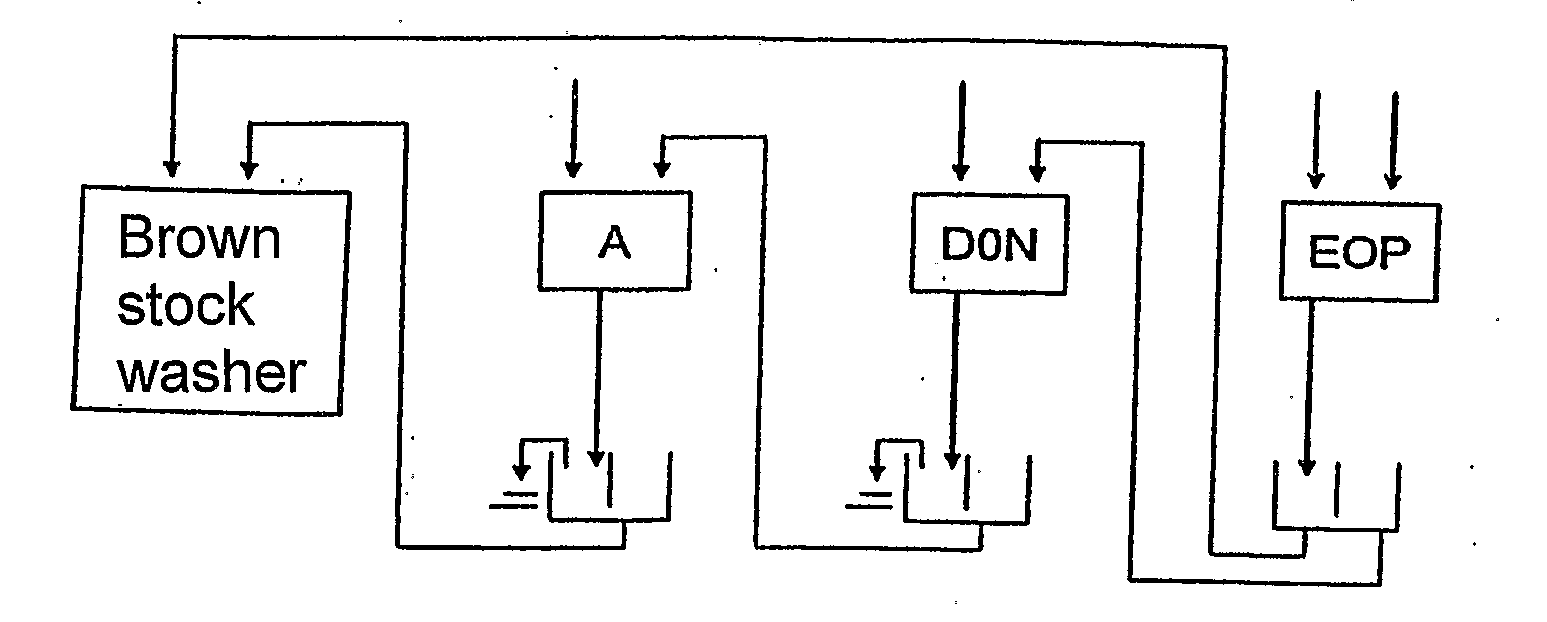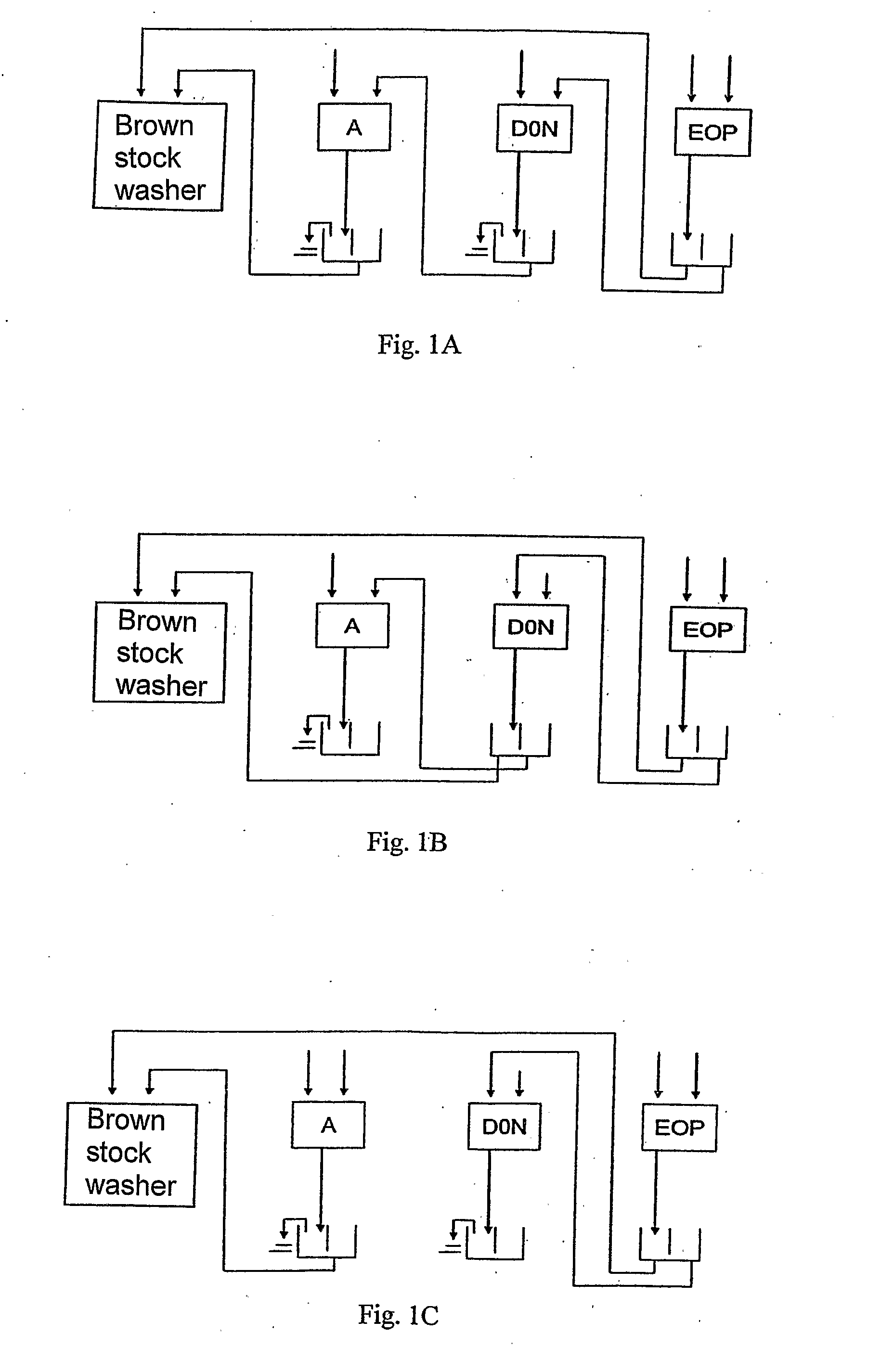[0018]The treatment for removing transition metals belonging to the initial bleaching according to the invention, may be, for instance, a separate
acid treatment (A) and washing of the pulp prior to the D0N stage. Said treatment to reduce the content of transition metals may also be e.g. a separate chelating step prior to the D0N stage. Said treatment could also be a separate treatment subsequent to the D0N stage, whereby the initial bleaching sequence would be D0N Q EOP. Acidification (A) of pulp entering the bleaching as a step carried out just before the D0N stage is especially advantageous, since adjustment of the pH value up and down will then be avoided. When the temperature is sufficiently high, e.g. from 80 to 95° C., during the
acid treatment stage (A), also hexenouronic acids consuming bleaching chemicals can simultaneously be removed, which is advantageous particularly when hard wood pulp is used.
[0019]The first
chlorine dioxide treatment of the initial bleaching according to the invention may be carried out under the conditions of a conventional D0 stage. In the process according to the invention, the
retention time in the chlorine dioxide treatment is from 10 sec to 120 min, preferably from 1 to 30 min, most preferably from 1 to 15 min, the active chlorine dosage (kg / adtp) is about 2 to 2,5 times the
kappa number or from 10 to 60 kg as active chlorine per
ton of air dry pulp (hereafter expressed as kg act. Cl / adtp), preferably from 20 to 50 kg act. Cl / adtp, most preferably from 15 to 40 kg act. Cl / adtp, the final pH is from 1 to 5, preferably from 2 to 3,5, and the thickness is from 1 to 40%, preferably from 3 to 15%. The temperature is preferably between 50 and 95° C., usually between 50 and 65° C. The addition of alkali after the addition of chlorine dioxide in order to adjust the pH value to be neutral or basic lowers the
kappa number of the pulp and improves the effectiveness of the following bleaching stages, reducing thus the consumption of the chemicals in the bleaching. In the first chlorine dioxide stage of the bleaching, the dosage of the chemicals may be reduced, if desired. When the required chemical dosage is smaller, the charged chlorine dioxide is consumed very rapidly and the required
retention time in the chlorine dioxide treatment is decreased. The decreased need of chlorine dioxide results in a decrease in the consumption of alkali in the alkalizing step following the D0 treatment. In the D treatment of the D0N stage, the pulp may, in addition to chlorine dioxide, be treated also with
ozone,
peracetic acid or caron acid or a combination thereof.
[0020]The alkali treatment to be carried out at the end of the chlorine dioxide stage lowers the
kappa number after the initial bleaching, enabling thus the use of a smaller dosage of chlorine dioxide to obtain a particular kappa number. Due to this, the
retention time in the chlorine dioxide treatment may be shorter than usually. The retention time in the chlorine dioxide treatment may further be shortened, if a hot
acid treatment (Ahot) carried out prior to the the chlorine dioxide treatment is used as a treatment to remove transition metals, because in that case chlorine dioxide is not consumed by hexenuronic acids, thus enabling a reduction of the chlorine dioxide dosage. In said hot acid treatment, the temperature is about 80 to 95° C.
[0025]When using
white liquor or oxidized
white liquor for alkalizing in the D0N stage, the Na / S balance of the chemical cycle may be adjusted in a new way, and foreign matters present in the
white liquor, such as Al, Cl, K and Si, may be removed. A decrease in the consumption of
sodium hydroxide in the EOP stage reduces the influence on the Na-balance of a mill, if the filtrates are conducted to the
recovery via brown stock washing. Compounds causing
precipitation, such as CaC2O4, CaCO3, BaSO4 as well as
magnesium compounds will precipitate onto the fibres when the pH rises. In a D0N
washer, the risk of
precipitation remains unchanged or decreases, and the demand for
magnesium addition in the EOP stage decreases. The
precipitation of
calcium carbonate may be controlled by limiting the rise of the pH in the N stage to a pH value of below 10.
[0028]Compared to the initial bleaching of the prior art, the initial bleaching sequence according to the invention enables to reduce the consumption of chlorine dioxide and peroxide as well as the use of shorter bleaching sequences. In one embodiment, the whole sequence of the bleaching consists of the initial bleaching sequence A D0N EOP according to the invention. In using the initial bleaching according to the invention, further preferred bleaching sequences are e.g. A D0N EOP D1, A D0N EOP P and A D0N EOP DP.
[0029]The filtrate resulting from a D0 stage of the prior art is acid. In the process according to the invention, the filtrate resulting from the D0N stage is neutral or basic, allowing thus the filtrate cycles in the bleaching to be arranged in a new way. A smaller amount of dissolved matter and chlorides facilitates conducting the filtrates resulting from the EOP stage to
recovery, for instance, via brown stock washing, enabling thus the reduction of the effluents resulting from the bleaching.
 Login to View More
Login to View More 


